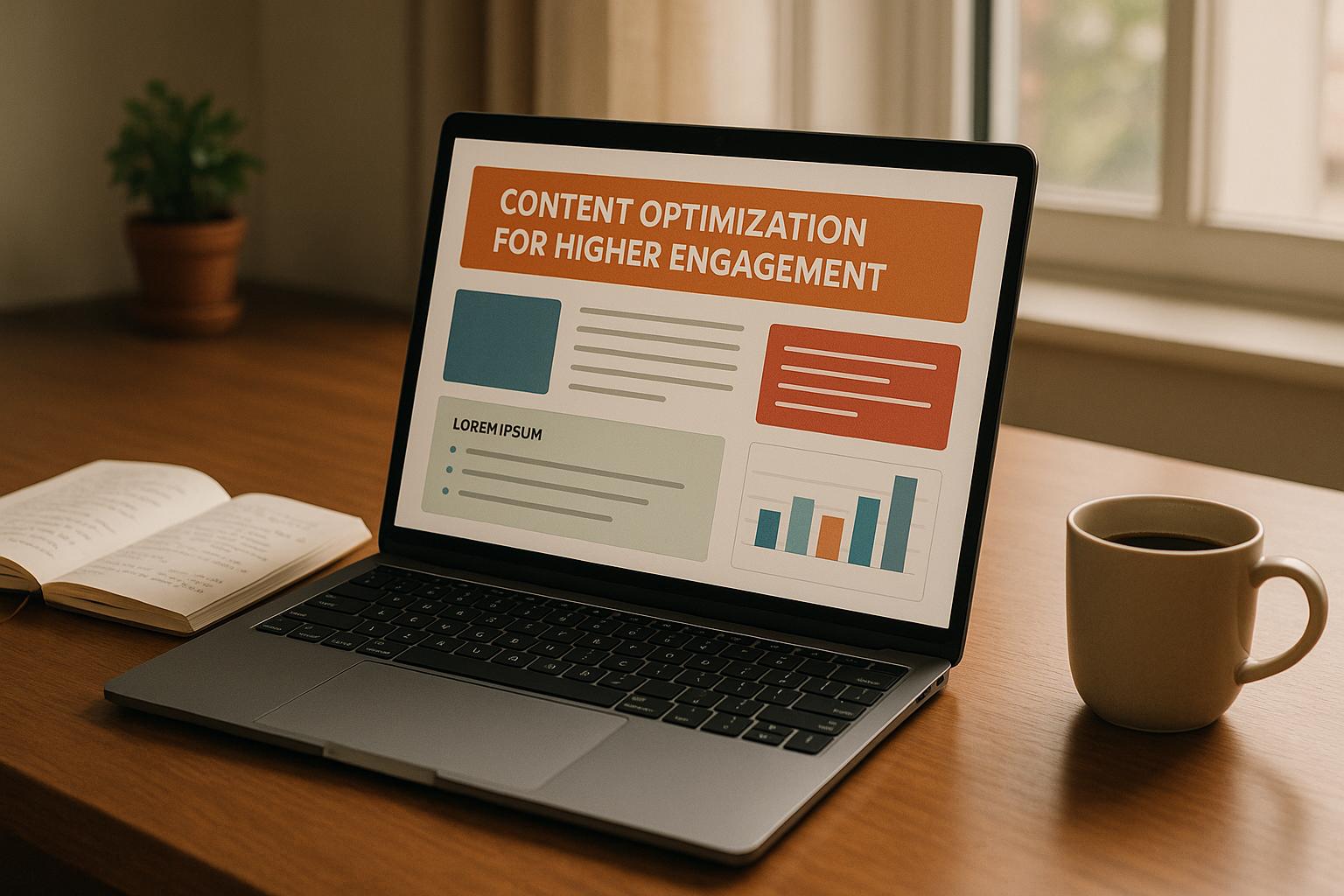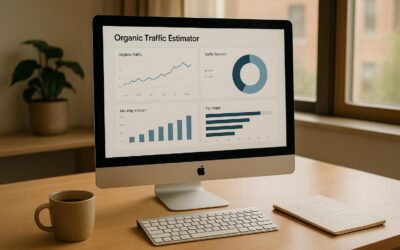Want more engagement from your content? Start by optimizing it. Here’s how:
- Understand Your Audience: Use analytics tools to learn what your readers want, then create detailed personas to guide your content.
- Strategic Keyword Use: Research and place keywords naturally in titles, headings, and throughout your content.
- Improve Readability: Use short paragraphs, clear headings, and bullet points to make your content easy to skim.
- Add Visuals: Include images, videos, or infographics to keep readers interested. Optimize them for fast loading.
- Mobile Optimization: Ensure your content works well on mobile devices with responsive design and quick load times.
- Track Performance: Monitor metrics like time on page, bounce rate, and conversions. Use the data to update and refine your content.
Key takeaway: Content optimization isn’t a one-time task. It’s an ongoing process that helps you attract more traffic, boost engagement, and achieve your goals. Focus on creating content that’s useful, easy to find, and enjoyable to read.
How Optimizing for Search Intent Improved Engagement by Over 250%
Know Your Target Audience
Understanding your audience is the cornerstone of effective content creation. When you truly know who you’re speaking to, you can craft messages that address their needs, interests, and challenges directly. This approach isn’t just a nice-to-have – it’s a game-changer. Studies show that 80% of consumers prefer personalized ads, and 91% are more likely to shop with brands that recognize their preferences and offer relevant recommendations. On the flip side, generic, cookie-cutter content often fails to make an impact.
"Tailored messaging is not just about changing a few words here and there. It’s about deeply understanding the people you are communicating with and crafting messages that resonate with them on a personal level." – Saba Gardezi
Use Analytics for Audience Data
Analytics tools are a goldmine for understanding your audience. Platforms like Google Analytics, Adobe Analytics, and Mixpanel can provide insights into who your audience is and how they interact with your content. Look at demographics such as age, gender, location, and interests, as well as behaviors like browsing patterns, engagement levels, and time spent on your site. Key metrics to monitor include website traffic trends, click-through rates, referral sources, and social media engagement. These data points reveal what resonates most with your audience and which platforms deliver the best results.
For example, MAPFRE, a leading insurance company, used audience segmentation to tailor its marketing campaigns. By focusing on specific topics of interest for each segment, they achieved a 2.65% engagement rate for personalized content – compared to 2.27% for non-personalized posts – while lowering costs per click and engagement. Similarly, Chanty, a team collaboration app, discovered through customer surveys that users prioritized the app’s interface and customer experience over pricing. Highlighting these strengths led to an 18% increase in sales.
Create Audience Personas
Once you’ve gathered enough data, the next step is to convert those insights into detailed audience personas. These personas are fictional profiles that represent your ideal customers and help guide your content strategy. As Ardath Albee puts it:
"A marketing persona is a composite sketch of a key segment of your audience."
A well-crafted persona includes specifics like job roles, content preferences, and engagement habits. It might outline preferred topics, platforms, and content formats, even assigning a name and profile picture to make the persona feel tangible. For example, Simul Docs, a collaboration tool for lawyers, creates personas that detail industry roles, pain points, and decision-making triggers.
To build accurate personas, combine data from analytics tools and CRM platforms like HubSpot with qualitative insights from customer surveys, interviews, and social media listening. Go beyond surface-level details – explore both the professional and personal challenges your audience faces. This depth will help you create content that truly connects. Keep these personas current by revisiting them yearly or whenever your brand strategy evolves. Share them across your organization – from PR to customer support – to ensure everyone is aligned.
The payoff is undeniable: segmented email campaigns can boost revenue by 760%, and personalization can drive a 10–15% increase in revenue. These foundational insights will set the stage for better keyword strategies and content formatting in the steps ahead.
Place Keywords Effectively
To connect with your audience and improve visibility, placing keywords strategically is key. This isn’t about stuffing keywords into every nook and cranny – it’s about weaving them into your content naturally. Done right, this helps search engines understand your content while keeping it engaging for readers. As Rachel Leist aptly notes:
"Keyword research isn’t just about finding words with high search volume – it’s about finding the right words".
The goal is to strike a balance by choosing keywords that are achievable to rank for and allow you to create high-quality content. Long-tail keywords – those longer, niche-specific phrases – are especially important. They often face less competition and, as Kalepp highlights:
"Targeting those long-tail keywords, because a lot of times the competition is lower on them. And it allows you to really develop a niche and allows you to rank".
These phrases tend to attract users with clear intent, leading to better conversion rates. Incorporating these keywords thoughtfully is the first step in creating content that aligns with user needs.
With mobile searches now making up 60% of all search activity, it’s also critical to incorporate mobile-friendly keywords, such as "near me" or "nearby." Local businesses, in particular, should focus on location-specific terms to attract nearby customers.
Competitor analysis can further refine your keyword strategy. Tools like Google Search Console can help you identify which keywords are already driving traffic to your site. From there, study your competitors to uncover opportunities where you can stand out. For a deeper dive, services like SearchX’s keyword research can help pinpoint high-impact keywords tailored to your industry.
Ultimately, focus on keywords with solid search potential but manageable competition – terms that allow you to create meaningful, user-focused content.
Research Keywords
Effective keyword research starts with understanding what your audience is searching for. Look at relevance, authority, and search volume when evaluating potential keywords. Begin with brainstorming sessions where your team identifies terms based on customer interactions. Then, expand your list using tools like Google Autocomplete and Google Keyword Planner to find related terms and their search volumes. Don’t forget to ask your customers directly – survey them about the phrases they use to find your services.
Add Keywords Naturally
Once you’ve identified your target keywords, the next step is placing them where they’ll have the most impact. Thoughtful keyword placement signals search engines about your content’s relevance while keeping it easy to read. Aim for a natural flow – avoid forcing keywords into sentences, as this can disrupt the reader’s experience.
Start with your title tags and headings. Include your primary keyword in the title tag (alongside your company name, if applicable) and use it in the H1 tag. Subheadings (H2 tags) are another great place to incorporate both primary and secondary keywords to structure your content effectively.
Meta descriptions also matter. Use your primary keyword once or twice within the 160-character limit, and include a secondary keyword if it fits naturally. These short summaries can make a big difference in attracting clicks.
Place keywords early in your content – ideally within the first 200 words – so search engines can quickly grasp the topic. But don’t overdo it; forcing a secondary keyword into the opening sentence can feel awkward.
Don’t overlook images. Optimize them with alt text that includes your target keywords.
To improve readability, break your content into smaller paragraphs, use bullet points sparingly, and highlight key ideas. This approach not only makes your content easier to digest but also provides natural opportunities to integrate your keywords.
Lastly, keyword mapping – planning where each keyword will appear – ensures your content stays focused and avoids internal competition between terms. Regularly updating your content helps keep it aligned with changing search trends and user expectations.
Format Content for Better Engagement
Once you’ve strategically placed your keywords, the next step is to refine how your content looks. Why? Because presentation matters – a lot. Around 80% of readers scan web pages rather than reading them word-for-word, so grabbing attention quickly is key. Well-organized content not only keeps visitors engaged but also encourages them to stay longer. For context, the top 10 search results average 3 minutes and 10 seconds of time on site.
The goal? Make your content easy to skim. When people can find what they need fast, they’re more likely to connect with your message.
Improve Readability with Structure
Headings and subheadings are like signposts – they guide readers to the information they care about. Think of them as a roadmap that helps users navigate your content effortlessly. To achieve this, break your text into smaller, digestible sections with clear subheadings. This is especially important since most readers are skimming rather than reading line by line.
Every heading should clearly reflect the content it introduces and follow a logical sequence. But don’t overdo it – too many headings can overwhelm readers and detract from your message.
Short paragraphs are another must. Long blocks of text can feel daunting, particularly on mobile screens. Aim for 2-3 sentences per paragraph to create breathing room and make your content more approachable.
Consistency is just as important. Use the same formatting style throughout your piece, whether it’s for headings, bullet points, or font choices. This uniformity not only looks professional but also helps readers navigate more efficiently.
For accessibility, proper heading structure is essential. Screen readers rely on headings for navigation, so a well-organized layout ensures your content is inclusive.
Once your structure is solid, visuals can take your content to the next level.
Add Visual Elements
Visuals are a powerful way to grab attention and keep readers engaged. In fact, people process visuals 60,000 times faster than text, making images, videos, and infographics indispensable tools.
The numbers speak for themselves: posts with images are 2.3 times more likely to get engagement, and adding video to landing pages can increase conversions by up to 86%. Interactive features like polls, quizzes, and surveys also encourage readers to participate, creating a deeper connection with your audience.
"Visual content is inherently more engaging than text alone." – Ronn Torossian, Everything PR News
When choosing visuals, go for authenticity. Genuine, relatable images resonate more with audiences than generic stock photos or AI-generated content. User-generated content, in particular, builds trust and feels more relatable.
Consistency in your visual branding is just as important. Stick to the same color schemes, fonts, and imagery styles across all content to create a cohesive experience that reinforces your brand identity.
Don’t forget to optimize your visuals. Use descriptive alt text with relevant keywords, choose meaningful file names, and compress images to ensure fast loading times without sacrificing quality.
As visuals enhance engagement, it’s equally critical to ensure that your content performs seamlessly on mobile devices.
Optimize for Mobile Users
With 62.7% of users accessing the internet via mobile phones and mobile devices accounting for over 50% of global web traffic, mobile optimization is no longer optional – it’s a necessity.
Mobile users expect content that’s quick to load and easy to digest. In fact, 53% of users abandon sites that take more than 3 seconds to load. They’re also looking for information they can access on the go.
Responsive design is a must. Your content should adapt to different screen sizes, ensuring text is readable without zooming and buttons are easy to tap. Smooth navigation is key – features like touch gestures should work seamlessly.
Loading speed is another critical factor for mobile users. Compress images, minimize large files, and consider tools like Accelerated Mobile Pages (AMP) to help your content load faster. On mobile, every second counts.
Streamline navigation by using larger, tap-friendly elements. Place the most important information at the top of the page, as mobile users are more likely to engage with content that’s immediately visible.
For forms, keep things simple. Minimize required fields and enable auto-fill options to make the process faster. Clear, easy-to-read call-to-action buttons also perform better on smaller screens.
Finally, consider features tailored for mobile users, like local search optimization. Many mobile users search for nearby businesses, so including location-specific details and claiming your Google Business Profile can significantly boost engagement.
Regular testing across various devices and browsers ensures your mobile experience remains smooth. What works on one device might not work on another, so consistent testing is key to keeping your content accessible.
sbb-itb-880d5b6
Analyze and Improve Content Performance
Measuring how well your content performs and using that data to make improvements is what drives real engagement. While 60% of marketers see content as a key part of their digital marketing strategy, fewer than one-third feel their strategy is highly successful. What sets the successful apart? They focus on tracking the right metrics and using the insights to refine their approach.
"Data enables me to make smarter decisions for the business, my audience, and myself. If I keep an eye on the right content metrics, I can learn a lot about content performance, my audience’s preferences, and my approach to creating and sharing content."
– Jeremy Yancey, Head of Content, Tability
Track Key Engagement Metrics
To understand how your audience interacts with your content, focus on metrics that reveal true engagement. For instance, while pageviews show traffic volume, average time on page tells you whether readers are actually engaging with your material. If you’re seeing lots of pageviews but very short times on page, it might mean your headline is pulling people in, but the content isn’t delivering what they expected.
Bounce rate is another important metric. A high bounce rate suggests your content isn’t connecting with visitors. Pairing this data with unique visitor counts can give you a fuller picture of your content’s reach and effectiveness.
Don’t forget to track conversions. Metrics like lead generation and return on content investment (ROCI) reveal which types of content are driving results. These insights can guide you toward the formats and topics that work best for your audience.
Social media engagement – through shares, likes, and comments – can also highlight what resonates with your audience. Similarly, organic search traffic is especially valuable because it brings in consistent visitors without requiring ongoing ad spend.
"Engagement shows whether audiences find content valuable enough to interact with. High engagement signals relevance, while low engagement suggests a need for improvement."
– Lauren Basiura, Writer, Marketing Insider Group
By combining these metrics, you can create a well-rounded view of your content’s performance. The key is to focus on metrics that align with your business goals and use them to shape your strategy.
Update Content Based on Data
Once you’ve gathered the data, use it to refine your content. Look for patterns that highlight what’s working and what isn’t. For example, headlines with numbers tend to draw 20% more attention than generic ones. If your click-through rates are underwhelming, experimenting with different headline styles could be worth trying.
A/B testing is another powerful tool. Compare variations of headlines, opening paragraphs, or call-to-action placements to see which performs better.
Studying how users navigate your site can also provide insights. If visitors frequently drop off at certain points, those sections may need improvement. Similarly, optimizing internal links can encourage readers to explore more of your content.
Sentiment analysis can help you understand how your audience feels about your brand. By monitoring social media conversations and comments, you can adjust your messaging to better align with audience expectations. Customer support data is another goldmine for content ideas – recurring questions or issues often point to topics that need more clarity or coverage.
"Average session duration is one of those signals based on merit, meaning it’s hard to game it. You can’t improve it by advertising, by stuffing more keywords onto your page, or by writing more clickbaity headlines."
– Dann Albright, B2B Marketing Writer
Regular content audits are essential for keeping your site relevant. Identify posts with declining traffic, outdated information, or keywords that no longer match current search trends. Advanced tools can make this process more effective.
Use Professional Tools
Professional tools can take your content analysis to the next level. For example, Google Search Console helps you understand how users find your content and reveals keyword opportunities.
SearchX is another option, offering detailed content performance analysis and optimization strategies. Their expertise in keyword research, on-page optimization, and content creation helps you turn raw data into actionable steps for growth.
These tools also allow you to monitor industry trends and benchmark your performance. Companies that use real-time analytics are 3.9 times more likely to see transformative business outcomes. Even small gains in customer loyalty – just 5% – can lead to profit increases between 25% and 95%.
Conclusion: The Path to Higher Engagement
Optimizing your content isn’t a one-and-done task – it’s a process that builds momentum over time. Businesses that focus on content marketing often achieve three times more leads than those that don’t, all while spending 62% less compared to traditional marketing methods.
A winning content strategy comes down to a few essentials: understanding your audience, placing keywords where they matter, designing content that’s easy to read, and consistently analyzing performance. These core elements – audience insight, keyword placement, reader-friendly formatting, and ongoing evaluation – work together to create content that doesn’t just attract visitors but keeps them engaged and coming back for more.
Publishing high-quality content on a regular basis can increase traffic by up to 97% and improve retention rates by 50%. Blogs that integrate SEO best practices see even greater gains in web traffic. The key? Focus on creating meaningful, well-crafted content rather than churning out large volumes of mediocre material.
Successful content creators constantly test, measure, and refine their approach, staying flexible to adapt to what works best. With 68% of online experiences starting with a search engine, your content must be easy to find, provide real value, and captivate from the very first click.
Tailoring your content format to your audience’s preferences can also make a big difference. Whether it’s videos, infographics, or written articles, the format matters. For instance, 72% of consumers prefer learning about products through video, while infographics are shared three times more often on social media compared to other types of content.
Beyond traffic and clicks, content marketing is about building trust and loyalty. When you create content that genuinely helps your audience, you’re not just marketing – you’re fostering relationships that lead to long-term growth. Over time, this trust translates into credibility and customer loyalty.
As search trends evolve and new platforms emerge, the strategies outlined here remain your guide. While algorithms and audience preferences may shift, businesses that prioritize understanding their audience, crafting quality content, and using data to refine their efforts will always find ways to connect. Your content becomes more than just a marketing tool – it becomes a bridge between your expertise and your audience’s needs.
Start with what you have, and focus on making steady, small improvements. Every piece of optimized content you create is an investment in your brand’s future and a step toward earning your audience’s trust.
FAQs
How do I create audience personas to improve my content strategy?
How to Create Effective Audience Personas
Building effective audience personas starts with deeply understanding your audience. Begin by gathering customer data through surveys, interviews, and analytics. Look for key details like demographics (age, location, income), interests, behaviors, goals, and challenges. Once you’ve collected this information, group your audience into segments based on shared characteristics and patterns to create detailed profiles.
To make these personas practical, go beyond surface-level details. Include insights into their motivations, pain points, and how they prefer to communicate. For example, do they respond better to emails, social media, or face-to-face interactions? And don’t stop there – keep your personas up to date by using analytics and customer feedback to refine them over time.
When done right, these personas allow you to create content that speaks directly to your audience’s needs and interests, leading to stronger connections and better engagement.
How can I naturally include keywords in my content to boost engagement?
To weave keywords naturally into your content, begin by incorporating them in strategic spots like the title, headings, and within the opening and closing paragraphs. Make sure they fit smoothly into the text so they don’t feel forced or awkward. Steer clear of keyword stuffing – it can hurt both readability and your search rankings.
The priority should always be crafting engaging, well-written content that connects with your audience while staying aligned with search engine best practices. By focusing on what your readers want, keywords will naturally find their place, boosting both usability and engagement.
How can I use data analytics to improve my content’s engagement and performance?
To make your content more engaging and effective, dive into data analytics by keeping a close eye on metrics like click-through rates (CTR), engagement levels, and audience behavior patterns. These numbers reveal what your audience connects with the most.
Experiment with A/B testing to see what works best. Try out different headlines, tweak your content formats, and adjust posting times to uncover the combinations that yield the strongest results. Digging into search trends and audience demographics can also give you a clearer picture of what your audience wants, helping you shape a strategy that aligns with their interests.
Make it a habit to check your analytics regularly. Trends and preferences are always shifting, so staying flexible and refining your approach ensures your content stays relevant. This ongoing process can help you achieve higher engagement and more impactful results over time.




